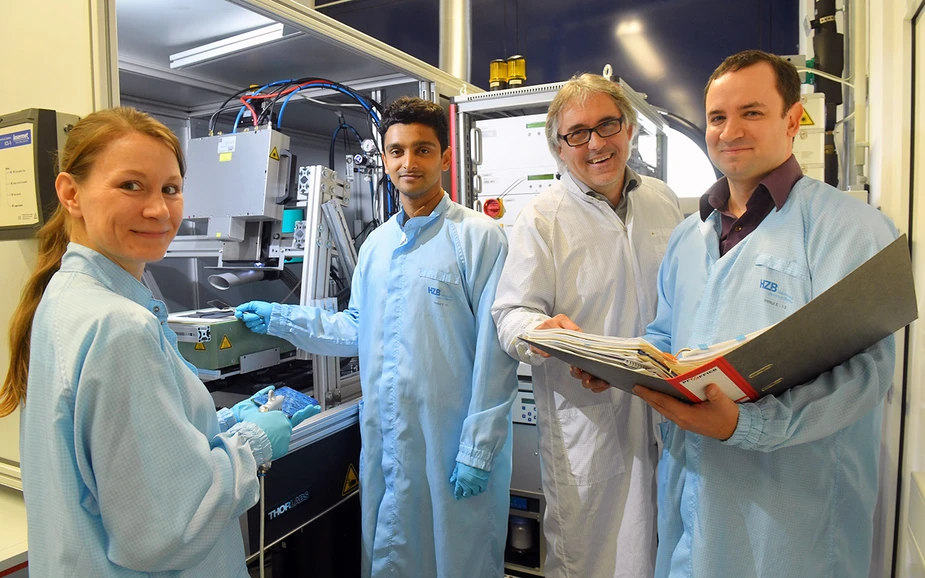Sprinting towards the tandem cell
How the Helmholtz Innovation Lab HySPRINT brings together business and research
Researchers at the Helmholtz Innovation Lab HySPRINT conduct application-based research on promising solar cells. The development of their refined ideas depends on bringing working together with the industry.
A magical sparkle emanates from the blue, chocolate-bar-sized square that Stefan Gall puts on the table. It is reminiscent of an abstract painting without a suitable frame. However, the meeting room at the Helmholtz Innovation Lab HySPRINT does not showcase art. Project leader Gall is presenting the results of a joint project with the company LIMO (Lissotschenko Mikrooptik) GmbH. “Our micro lenses are made specifically for beam shaping of high-performance lasers,” says Dirk Hausschild, marketing chief at LIMO. Founded 25 years ago, the specialists of the Dortmund-based company can heat the temperature of ultra-thin surfaces to 1,500 degrees Celsius and cool them down in a matter of seconds. This method serves to improve the properties of, say, a semiconductor without damaging the underlying material.
In the joint project with HySPRINT, researchers use a linear laser beam to melt an ultra-thin layer of silicone (a thousandth millimetre) on a sheet of glass with extreme precision. Upon cooling, tiny silicone crystals appear along the laser line that grow over time. The end result are multi-crystalline layers of silicon on a sheet of glass, which can be used for producing solar cells. “Those layers are thinner and easier to produce than conventional silicon wafers,” says Gall.
HySPRINT stands for “Hybrid Silicon Perovskite Research, Integration & Novel Technologies” an innovative facility at the Helmholtz-Centre Berlin (HZB). They deal with highly efficient tandem solar cells, which contain silicone and other semi-conductor materials. Metal-organic perovskites are currently in high demand. Each material absorbs a different segment of the light spectrum. The perovskite at the top absorbs the short-wave light segment with high energy, while the underlying silicone absorbs the long-wave segments. “The combination of silicon and perovskite is an important topic for HySPRINT,” says Gall, who is a professor for photovoltaics at the Technical University Berlin. The Berlin native completed his PhD there, worked in the industry and then became a researcher at the Hahn-Meitner-Institute in November 2000, which is now part of the HZB.
The HySPRINT is one of seven Innovation Labs in Germany, which were set up by the Helmholtz Association of German Research Centres to foster application-based research, technology transfer and cooperation with the industry. “We started receiving funding for two years in early 2017. But if all goes well, we might get funding for another two years,” says Gall. After the initial funding phase by the Helmholtz Association, the labs plan to continue their work and obtain most of their funds on their own accord.
HySPRINT is involved in another joint project dealing with perovskite solar cells in cooperation with the working group “Experimental Physics” of the Humboldt-Universität zu Berlin. Widespread and large-scale use of the promising material will require new and cheaper methods. One way of achieving this are printing methods, which working group leader Prof. Emil List-Kratochvil and his staff are well-versed in. “It is scalable in unlimited ways,” says Gall. The project leader of HySPRINT is convinced that the focus on perovskites and the tandem solar cell is the right way to go. With an efficiency of almost 27%, silicon-based photovoltaics are slowly approaching the theoretical maximum of 29%. After the initial funding phase, the Helmholtz Innovation Labs are striving to become an important partner for application-based research and technology transfer in various fields.
By Paul Janositz for Adlershof Journal
